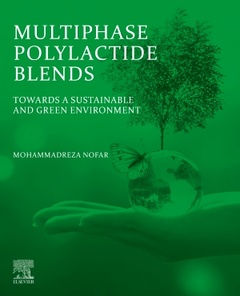Description
Multiphase Polylactide Blends
Toward a Sustainable and Green Environment
Author: Nofar Mohammadreza
Language: English
Subjects for Multiphase Polylactide Blends:
Keywords
404 p. · 19x23.4 cm · Paperback
Description
/li>Contents
/li>Biography
/li>Comment
/li>
Multiphase Polylactide Blends: Toward a Sustainable and Green Environment guides the reader through fundamentals, science, preparation, and key areas of innovation in polylactide (PLA) blends. Bio-based polymers, and notably PLA, have not only gained increasing interest as a more sustainable alternative but also bring challenges in terms of mechanical, rheological, thermal and physical properties, processability, shapability, and foamability. The use of blends looks to address these, with the development of new types of economically viable and environmentally friendly systems. This is a valuable book for academic researchers, scientists, and graduate students across bio-based polymers, polymer science, chemistry, and materials science, as well as engineers, R&D professionals, and all those in industry with interest in PLA-based blends, biopolymers, and sustainable materials and products.
More specifically, the first three chapters of this book overview the fundamentals of thermoplastic polymers, polymer blends, and structure and properties of PLA. These chapters could technically be used as a valuable textbook on the noted topics. The rest of the chapters inclusively study the fundamentals, investigations, and achievements in PLA-based blends with various types of polymers. These include miscible blends of poly L-lactide and poly D-lactide, binary immiscible/miscible blends of PLA with other thermoplastics and elastomers, PLA-based ternary blends and blend nanocomposites, as well as PLA-based blend foams.
Overall, this book provides a thorough and critical overview of the state of the art in PLA-based blends, including significant past and recent advances, with the aim of supporting and shaping further research and industrial application of these materials for the development of a green and sustainable future.
Chapter 1. Fundamentals of thermoplastic polymers: molecular structure1.1 Introduction to natural and synthetic polymers 1.2 Thermoplastic polymers and crystal structures 1.3 Thermal and mechanical characteristics of thermoplastics 1.4 Transition temperatures and crystallization ReferencesChapter 2. Introduction to polymer blends 2.1 Introduction 2.2 Thermodynamics and phase miscibility 2.3 Immiscible blends: morphologies and properties 2.4 Compatibilization and interfacial properties 2.5 Mixing theories and processing 2.6 Ternary and hybrid polymer blendsReferencesChapter 3. Polylactide (PLA): molecular structure and properties 3.1 Introduction to biopolymers and PLA 3.2 Synthesis and molecular structure 3.3 Molecular stereochemistry configurations 3.4 Glass transition temperature 3.5 Crystallization and melting behaviors 3.6 Rheological properties3.7 Mechanical and physical properties3.8 Degradation behavior ReferencesChapter 4. PLLA/PDLA blends: stereocomplex crystals 4.1 Crystallization behavior 4.2 Mechanical properties 4.3 Rheological properties 4.4 Barrier and degradation propertiesReferencesChapter 5. PLA binary bioblends with other biopolymers 5.1 Blends of PLA with biobased and biodegradable polymers 5.2 Blends of PLA with biodegradable polymers 5.3 Blends of PLA with biobased polymers ReferencesChapter 6. PLA binary blends with petroleum-based nondegradable thermoplastics 6.1 PLA-PE 6.2 PLA-PP 6.3 PLA-PS 6.4 PLA-ABS 6.5 PLA-PMMA 6.6 PLA-PET 6.7 PLA-PBT 6.8 PLA-PTT 6.9 PLA-PC 6.10 PLA-PA 6.11 PLA-PEG, PEO, or POE 6.12 PLA-POM 6.13 PLA-PVPh ReferencesChapter 7. PLA binary blends with elastomeric polymers 7.1 PLA-rubber 7.2 PLA-PU7.3 PLA-EVA and EVM ReferencesChapter 8. Ternary blends of PLA 8.1 Introduction 8.2 PLA-TPS-X ternaryblends 8.3 PLA-PBAT-X ternaryblends 8.4 PLA-PBS-X ternaryblends 8.5 PLA-PMMA-X ternaryblends 8.6 PLA-Y-X ternaryblends ReferencesChapter 9. PLA blend nanocomposites 9.1 Introduction 9.2 Nanoparticles localization: thermodynamics vs kinetics mechanisms 9.3 Morphological stabilization 9.4 Morphological and rheological correlations 9.5 Induced functionalities 9.6 Mechanical properties 9.7 Structure-dependent applications 9.8 Summary Acknowledgement ReferencesChapter 10. Foaming of PLA blends 10.1 Introduction 10.1 Miscible PLA-PLA blend foams 10.2 PLA bioblend foams 10.3 PLA blend foams with synthetic/nondegradable polymers 10.4 PLA blend foams with elastomeric polymers ReferencesSummary and Perspectives
- Overviews the fundamentals of thermoplastic polymers, polymer blends, and the structure and properties of PLA.
- Provides detailed coverage of the fundamentals and science of PLA blends, including phase miscibility, thermal and mechanical properties, interface and rheological properties, the use of compatibilizers, and phase morphological analysis.
- Offers a thorough critical overview of the state of the art in processing and development of PLA-based blends, addressing key challenges and future perspectives.
- Covers the latest advances, including PLA-based ternary blends, blend nanocomposites, and PLA-based blend microcellular foams.




